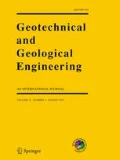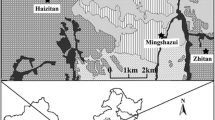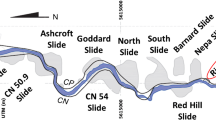Abstract
The Calvert Cliffs, which form much of the western coastline of the Chesapeake Bay in Calvert County, Maryland, are actively eroding and destabilizing, yielding critical situations for many homes in close proximity to the slope’s crest. Past studies have identified that waves directly interacting with the slope toe control cliff recession; however, where waves do not regularly interact with the slope toe, freeze–thaw controls recession. This study investigated the validity of this second claim by analyzing the recession rate and freeze–thaw behavior of six study sites along the Calvert Cliffs that are not directly affected by waves. While waves do remove failed material from the toe in these regions, freeze–thaw is believed to be the dominant factor driving recession at these sites. Past recession rates were calculated using historical aerial photographs and were analyzed together with a number of other variables selected to represent the freeze–thaw behavior of the Calvert Cliffs. The investigation studied sixteen independent variables and found that over 65 % of recession at these study sites can be represented by freeze–thaw through the following variables: (1) slope aspect, (2) soil freeze–thaw susceptibility, (3) the number of freeze–thaw cycles, and (4) the weighted shear strength. Future mitigation techniques at these sites should focus on addressing these variables. Unmitigated, the Calvert Cliffs will continue to recede until a stable slope angle is reached and maintained.






Similar content being viewed by others
References
American Concrete Pavement Institute (ACPA) (2008) Frost-suscpetible soils. Concrete pavement technology series. ACPA, Skokie, Illinois
Buckler WR, Winters HA (1983) Lake Michigan bluff recession. Ann Assoc Am Geogr 73(1):89–110
Budhu M (2007) Soil mechanics and foundations, 2nd edn. Wiley, Hoboken
Calvert County Government (2012) Aerial imagery and ArcGIS shapefile data. Prince Frederick, MD
Calvert County, Maryland, Department of Natural Resources, Maryland Department of the Environment, United States Army Corps of Engineers, United States Fish and Wildlife Service, and Maryland Emergency Management Agency (2010) Chesapeake bay cliff erosion in Calvert County: draft steering committee report
Clark I, Larsen CE, Herzog M (2004) Evolution of equilibrium slopes at Calvert Cliffs, Maryland: a method of estimating the timescale of slope stabilization. Shore Beach 72(4):17–23
Department of the Army Corps of Engineers Office of the Chief of Engineers (1984) Pavement criteria for seasonal frost conditions: mobilization construction. USA
Duncan JM, Wright SG (2005) Soil strength and slope stability. Wiley, Hoboken
Edil TB (2010) Erosion, slope stability, prediction of future recession in actively eroding slopes. Geotech Eng J SEAGS AGSSEA 41(4):185-192
Edil TB, Vallejo LE (1980) Mechanics of coastal landslides and the influence of slope parameters. Eng Geol 16:83–96
Force JDotAaA (1987) Arctic and subarctic construction: general provisions. Vol 1. USA
Gatto LW (1995) Soil freeze–thaw effects on bank erodibility and stability. US Army Corps of Engineers Cold Regions Research & Engineering Laboratory, Hanover, NH
Hampton MA, Griggs GB, Edil TB, Guy DE, Kelley JT, Komar PD, Mickelson DM, Shipman HM (2004) Processes that govern the formation and evolution of Coastal Cliffs. Formation, evolution, and stability of coastal cliffs—status and trends. U.S. Department of the Interior, U.S.A.
Hapke CJ (2004) The Measurement and Interpretation of coastal cliff and bluff retreat. Formation, evolution, and stability of coastal cliffs—status and trends. U.S. Department of the Interior, U.S.A.
Harlan RL, Nixon JF (1978) Ground thermal regime. In: Andersland OB, Anderson DM (eds) Geotechnical engineering for cold regions. Mc-Graw Hill Book Co., New York, pp 103–163
Holtz RD, Kovacs WD, Sheahan TC (2011) An introduction to geotechnical engineering, 2nd edn. Pearson Education Inc, Upper Saddle River
Kamphuis JW (1987) Recession rate of glacial till bluffs. J Waterway Port Coast Ocean Eng 113(1):60–73
Kidwell SM (1997) Anatomy of extremely thin marine sequences landward of a passive-margin hinge zone: neogene Calvert Cliffs succession, Maryland, U.S.A. J Sediment Res 67(2):322–340
McRoberts EC (1978) Slope stability in cold regions. In: Andersland OB, Anderson DM (eds) Geotechnical engineering for cold regions. Mc-Graw Hill Book Co., New York, pp 363–404
Michalowski RL, Zhu M (2006) Frost heave modelling using porosity rate function. Int J Numer Anal Method Geomech 30:703–722
Miller DS (1995) A Field Investigation of the controls of the dominant erosion processes on the actively undercut, non-lithified coastal slopes of Calvert County, Maryland. Dissertation. Johns Hopkins University, Baltimore, MD
Miller DS, Prince N, Miller BJ (2006) A best management plan for the shoreline and slopes along the scientists’ Cliffs shoreline of the chesapeake bay, Maryland. Scientists’ Cliffs Association, Port Republic, MD
NCDC/NOAA (2012) Integrated surface hourly climate data. Asheville, NC
Price JC (1980) The potential of remotely sensed thermal infrared data to infer surface soil moisture and evaporation. Water Resour Res 16(4):787–795
Schweitzer JP (1993) Observations of soil wash on steep, unvegetated slopes: Calvert County, Maryland. Thesis. Johns Hopkins University, Baltimore, MD
Shattuck GB (1904) Geological and Paleontological Relations, with a Review of Earlier Investigations. In: Clark WB, Shattuck GB, Dall WH (ed) The miocene deposits of Maryland. Maryland Geological Survey, pp 33–94
Sterrett RJ, Edil TB (1982) Ground-water flow systems and stability of a slope. Ground Water 20(1):5–11
Team RC (2012) R: a language and environment for statistical computing. R Foundation for Statistical Computing. http://www.R-project.org/
Ward LW, Andrews GW (2008) Stratigraphy of the Calvert, Choptank, and St. Marys formations (miocene) in the Chesapeake Bay area, Maryland and Virginia. Virginia Museum of Natural History, Martinsville, VA
Wilcock PR, Miller DS, Kerhin RT (1993) Calvert Cliffs slope erosion project phase II final report—processes and controls of coastal slope erosion. Charleston, SC
Wilcock PR, Miller DS, Shea RH, Kerhin RT (1998) Frequency of effective wave activity and the recession of coastal bulffs: Calvert Cliffs, Maryland. J Coast Res 14(1):256–268
Zwissler B (2013) A study of the impacts of freeze–thaw on cliff recession at the Calvert Cliffs in Calvert County, Maryland. Thesis. Michigan Technological University, Houghton, MI
Acknowledgments
Special thanks are owed to the Calvert County Department of Community Planning and Building and the Cliff Stabilization Advisory Committee for sharing their data, knowledge, and experiences to make this project possible.
Author information
Authors and Affiliations
Corresponding author
Rights and permissions
About this article
Cite this article
Zwissler, B., Oommen, T. & Vitton, S. A Study of the Impacts of Freeze–Thaw on Cliff Recession at the Calvert Cliffs in Calvert County, Maryland. Geotech Geol Eng 32, 1133–1148 (2014). https://doi.org/10.1007/s10706-014-9792-1
Received:
Accepted:
Published:
Issue Date:
DOI: https://doi.org/10.1007/s10706-014-9792-1




